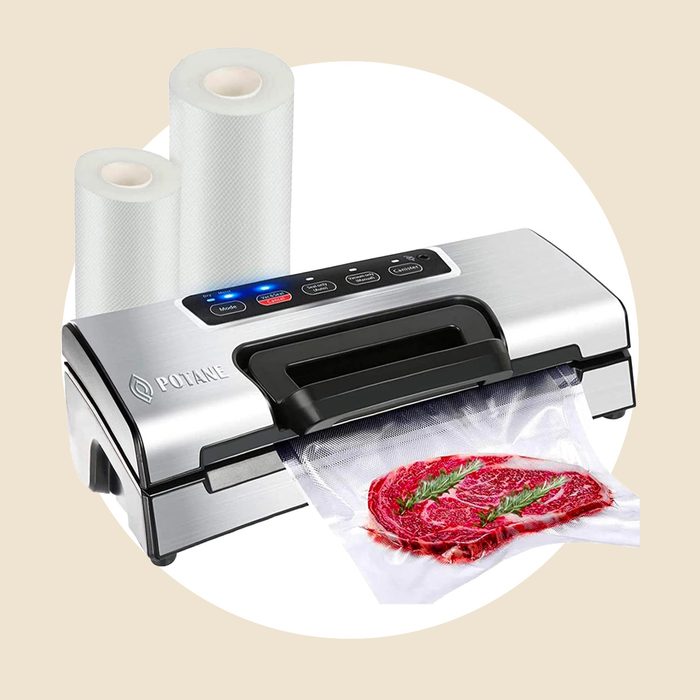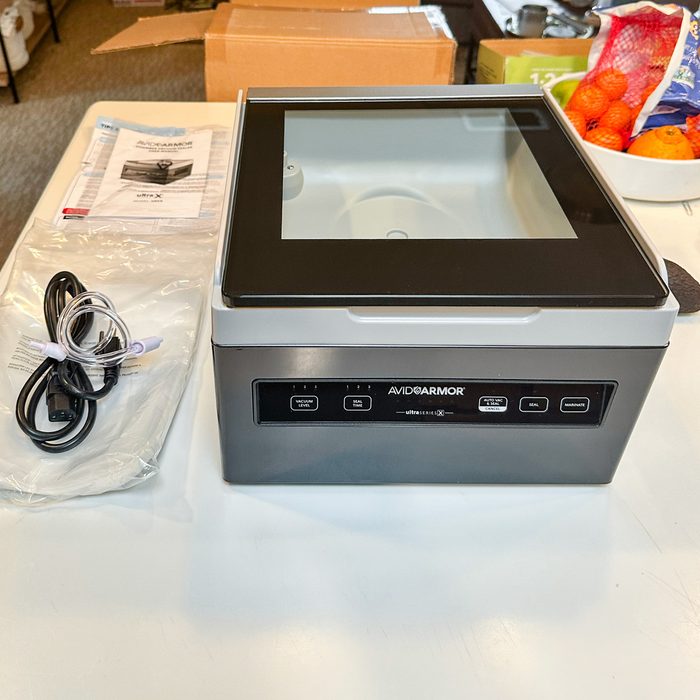Pros:
-
Easy, one-hand operation
-
Preserves foods at their maximum freshness for weeks
-
Includes two rolls of vacuum bags and an extra gasket
-
Two operating modes: automatic and manual
-
Compact size makes it easy to stash in a cabinet or drawer
-
Versatile uses not just for food
-
Built-in cutter
-
Powerful motor
A vacuum sealer is like the crème de la crème of prep tools, and this Potane vacuum sealer tops them all. Powered by 120 watts, it uses 8 millimeters of sealing width, whereas many other styles use only 3 millimeters. It’s an overall stand-out for its smooth sealing method and robust, high-power motor.
Plus, it stores up to 20 feet of bag rolls and features a built-in cutter that minimizes labor. It comes with a five-year warranty so that it can last for the long haul. It has both an automatic and a manual mode—a simple design that doesn’t compromise the most important features. You’ll be packing freezer foods like a pro before you know it.
SARAH FARMER FOR TASTE OF HOME
“I’m sold on the virtues of vacuum sealing, beyond sous vide cooking alone,” writes our executive culinary director, Sarah Farmer, in her Potane vacuum sealer review. “Prepping make-ahead meals for the freezer, preserving ingredients and extending the life of food and even protecting non-food items from the elements—the Potane did an all-around super job!”
Over the course of several weeks, Sarah tested out the Potane Precision by vacuum-sealing many foods for sous vide cooking and general sealing for storing and preserving. “I used both the ‘moist’ and ‘dry’ modes,” Sarah explains. “Proteins, with their high moisture content, were sealed on the ‘moist’ mode, while cheddar cheese, blanched broccoli florets and pre-frozen, portioned cookie dough balls were set to ‘dry.'”
In all her tests, the Potane Precision performed great. All the seals on the bags held firm, and there was no leaking. The only minor drawback Sarah found is the loud sound when the machine draws air out.
SARAH TRAMONTE FOR TASTE OF HOME
Pros:
-
Large 8-liter sealing chamber
-
Vacuum seals liquids with no mess
-
Creates a tough double seal
-
Comes with removable vacuum filler plate
-
Includes program for marinating
-
Low maintenance
-
Weighs 27 pounds
Though pricier than edge vacuum sealers, the Avid Armor chamber vacuum sealer delivers speed and versatility for sealing large food quantities. It features a stainless steel body, glass lid, and an 8-liter chamber (11.5 x 12 x 3.5 inches) ideal for big portions. Despite its 16 x 14 x 10-inch footprint, it’s compact for a chamber model and weighs less than 30 pounds.
Unlike edge or handheld models, chamber vacuum sealers remove air from both inside and outside the chamber for a cleaner, tighter seal. The Avid Armor is easy to use with one-touch controls, a pressure gauge, and a filler plate to speed up smaller jobs. It also features a pre-programmed marinate function that uses pressure to quickly infuse flavor into meats and seafood.
SARAH TRAMONTE FOR TASTE OF HOME
Sarah tested the Avid Armor in her kitchen and was impressed by its performance across various foods. It sealed chicken breasts with barbecue sauce in 31 seconds, showing only minimal freezer burn after two weeks. Thanks to the gentle pulse function, saltine crackers sealed in 15 seconds without breaking. The curved edges of fresh ginger were tightly sealed in 35 seconds with no visible air pockets.
The Avid Armor sealed avocado halves in 28 seconds and, after two days, delivered the best results of all the vacuum sealers Sarah tested. “While the avocado half was slightly pressed inward, it was the most fresh with the brightest green color at the end of the two-day test.” One hiccup: though the included bags worked well at keeping food fresh, Sarah noted they were hard to cut and resize.
Overall, the Avid Armor is a top-performing vacuum sealer when it comes to sealing large quantities of food and preserving freshness. “While it’s quite expensive and really big, it does get the job done—so if you have the space and the budget, go for it,” Sarah says.
Others We Tested
- FoodSaver Handheld+ 2-in-1 Vacuum Sealing System: Interested in the art of vacuum sealing, but not all the bulk? We tested this space-saving FoodSaver model, and appreciate that you don’t have to sacrifice storage or counter space. Not to mention, it’s the only system that combines the force of a countertop sealer with the convenience of a cordless, handheld one. However, it is expensive, and while it does have a marinate mode, it does not have all the functions and settings that some of the other models we tested have. More noteworthy, our testing proved that it could not work with delicate foods without damaging them.
- Weston Pro-2300 Commercial-Grade Vacuum Sealer: If you’re interested in taking meal prep seriously or just know that you will use your food sealer regularly, you may want to opt for this heavy-duty Weston Pro-2300 vacuum sealer. It possesses 935 watts of power, so its vacuum is much more powerful than the average vacuum sealer. Plus, its double piston pump makes it quick and efficient for cranking out big batches of sealed foods. While this one is a smart pick for anyone who uses a bulk meat delivery or produce delivery service, it’s also the most expensive vacuum sealer we tested. It’s large and heavy, and takes up a lot of space. It also doesn’t come with any bags or extra accessories.
- Zwilling Fresh & Save Vacuum Sealer: This is the smallest, most affordable vacuum sealer we tested. We like that it comes with sealable bags and containers that are freezer-safe, oven-safe and microwavable. Plus, the quiet and compact handheld pump is rechargeable. However, it came in last place during testing for preserving food freshness, vacuum sealing delicate foods and handling irregularly shaped foods without leaving behind air pockets.
What to Look for When Buying a Vacuum Sealer
When purchasing a vacuum sealer, here are a few things to keep in mind:
Type of Vacuum Sealers
- External Vacuum Sealers: Also known as edge sealers, this vacuum sealer sucks air directly out of a bag before sealing the open edge. These devices are more common, less expensive and smaller than their counterparts, but the vacuum mechanism is less efficient.
- Chamber Vacuum Sealers: Chamber sealers see the user place a bag and its contents inside its housing, pulling the air from the entire chamber evenly—including both inside and outside of the bag—creating an equally pressurized environment. Chamber sealers keep your ingredients in place and don’t suck any contents toward a vacuum mechanism.
Seal Bar Width
This applies exclusively to external vacuum/edge sealers and refers to the device’s width on the sealing side. It determines the maximum width of the sealer bags, as any bags wider than the seal bar won’t seal (since they’re longer than the sealer).
Ease of Use
- Controls and Settings: Vacuum sealer controls look very different, but they all operate similarly. Edge sealers have a simple array of control buttons, sometimes with a digital display. Chamber sealers are more complex, offering more sealing options and controls. However, all models function primarily with preset programs accessible by pushing buttons.
- Indicator Lights or Notifications: Vacuum sealers usually have indicator lights denoting which program is running and whether the device is operating. Sealers with a digital display share program run time and when the process is complete.
Bag Compatibility
SARAH TRAMONTE FOR TASTE OF HOME
Operating a vacuum sealer involves more than a trip to the store and buying plastic bags. Sealers are designed to work only with specific bags, as outlined in the user manual (many sealers come with bags). Shop for sealer bags specifically compatible with your sealer model.
Suction Power and Performance
- Suction Efficiency: This refers to the amount of air that a sealer sucks out of its vacuum bags. Remove as close to 100% of all air from a bag to maintain a proper vacuum seal. This is the most vital metric to consider when purchasing a vacuum sealer.
- Continuous Sealing Capability: Some sealers operate continuously, so you can feed multiple bags through the device. If you’re sealing a high volume of bags, prioritize this feature.
Maintenance and Durability
- Cleaning: Keeping your vacuum sealer clean is vital, especially when it comes to the seal bar of edge sealers, as any buildup could hamper their ability to function. Always clean your vacuum sealer between uses (and sometimes between bags during a single job), as this maintains the integrity of the seals and keeps your device functioning as intended.
- Build Quality: A good build quality is of the utmost importance with vacuum sealers, especially chamber sealers, as any significant flaws could impact the device’s performance ability. As with many kitchen appliances, those with metal constructions trend toward higher durability and quality. Still, many vacuum sealers are constructed with large amounts of plastic (which is not necessarily a knock against them, as this is standard for the category).
Size and Portability
Edge sealers tend to be smaller and more portable than chamber sealers, but there is also a lot of variation in size, even within the categories themselves. Check capacities and capabilities by consulting with the manufacturers (many outline device sizes online). The greater the seal bar width, the larger the device is.
There are even handheld, cordless vacuum sealer options on the market. However, there’s a direct correlation between size and capabilities, where smaller devices are more portable and easy to store but require smaller vacuum seal bags.
Additional Features
- Built-in Roll Storage and Cutter: Some vacuum sealers store extra bags for easy access, while others feature an integrated cutting tool, often a simple slider, allowing you to customize and cut bags from the roll quickly.
- Accessory Port: An accessory port adds versatility to your vacuum sealer, enabling you to seal non-bag items like mason jars—perfect for preserving jellies, jams or pickled foods.
Noise Level
Like most kitchen gadgets, vacuum sealers make noise, similar to an air compressor, but only while in operation. If your vacuum sealer becomes unusually loud, turn it off and seek professional maintenance.
For reference, tester Sarah Tramonte downloaded an app that measures noise level to record the noise level of each vacuum sealer she tested. The loudest sealer she tested measured in at about 88 dBA, which isn’t too much louder than a blender.
Price and Warranty
- Cost: Vacuum sealers cost around $70 to $400. Chamber models almost always cost more than edge sealers.
- Warranty: Vacuum sealers often come with warranties ranging from one to five years. Check with the manufacturer for coverage details and instructions on accessing the warranty (registration may be required).
How We Found the Best Vacuum Sealers
To find the best vacuum sealers, we first researched the market itself, getting a feel for the brands and products that were widely available. Then, we narrowed our search by selecting those trusted by consumers and industry experts. Next, we considered individual vacuum sealer model specifications, including motor power, size, sealing modes and other features. Once we picked a handful of top vacuum sealer models, we called in our experts to test the products.
Sarah Farmer and Sarah Tramonte tested all the vacuum sealers mentioned above. Farmer leads the Taste of Home culinary team, and Tramonte, a former culinary producer for Taste of Home, has experience as a food stylist and recipe developer. Together, they tested a series of vacuum sealers, evaluating performance, usability, noise level and overall seal quality.
Each of our product testers evaluated the vacuum sealers in real kitchen environments to see how well each one performed across a range of everyday tasks. They vacuum-seal a variety of foods, from delicate items like saltine crackers and irregularly shaped produce like ginger, to liquid items like marinated meats. They examined the quality and durability of the seals after storage to determine which vacuum sealers preserved food most effectively.
FAQ
SARAH TRAMONTE FOR TASTE OF HOME
How do you use a vacuum sealer?
Vacuum sealing removes oxygen from bags or containers, creating an airtight seal that extends the life of food. You’ll want to begin by preparing your food and bag or container for sealing. Then you’ll fill the bag or container with the food you wish to preserve, and use the vacuum sealer to complete the process.
Can you vacuum seal bread?
Yes, you can. Creating an airtight seal around bread can delay the growth of mold. However, vacuum sealing bread may also crush it and alter its shape.
Can you vacuum seal lettuce?
Yes, you can vacuum seal lettuce and store it in the fridge or freezer. In the fridge, the shelf life will be extended by several days. In the freezer, vacuum-sealed lettuce can last months.
How long does vacuum-sealed food last?
If kept in the refrigerator, vacuum-sealed food stays fresh for one to two weeks. In the freezer, it can last five to six months. Depending on your freezer’s capacity, vacuum-sealed food can sometimes last one to two years.
How long does vacuum-sealed meat last?
According to FoodSaver, vacuum-sealed beef and poultry can last two to three years, making vacuum sealing one of the best ways to preserve meat.
What foods should you not vacuum seal?
You shouldn’t vacuum seal soft cheeses, onions, garlic, raw veggies (broccoli, Brussels sprouts, kale, arugula, cabbage, and radishes), raw mushrooms, raw bananas and whole apples.
How do you clean a vacuum sealer?
Unplug the machine and wait for it to cool down before cleaning. Then, use a damp cloth to wipe and remove any loose crumbs, dirt or food residue.
How do I choose a good vacuum sealer?
Choosing a good vacuum sealer depends on your needs. A basic edge sealer should suffice if you only occasionally seal small items. An industrial-grade model might be more appropriate for sealing large quantities of food. Customer reviews and professional recommendations, like those in our guide, can help you make an informed decision.
Why are chamber vacuum sealers better?
Chamber vacuum sealers are more efficient and cleaner than edge sealers. They equalize the pressure inside and outside the bag during sealing, preventing the contents from shifting or leaking, a common issue with edge sealers.
What is the best vacuum sealer for large cuts of meat?
This depends on your budget, space and numerous other factors, but you can’t go wrong with our overall pick, the Potane vacuum sealer.
How long does a vacuum sealer machine last?
A vacuum sealer typically lasts two to three years with regular use. However, with proper care and maintenance, it can last even longer.
Why You Should Trust Us
Sarah Farmer brings 20 years of food publishing experience and leads the Taste of Home culinary team, specializing in recipe development, editing, testing and food styling. She appears in Taste of Home videos on YouTube and TV, sharing insights on recipes and kitchen gadgets, and speaks at culinary events nationwide. She has extensive experience in product reviews and kitchen appliances and is well-qualified to review vacuum sealers.
Sarah Tramonte, a former culinary producer for Taste of Home, has six years of professional experience as a food stylist and recipe developer. With deep knowledge of how to make food look great and taste even better, she brings technical expertise and an eye for detail to her product testing. She recently tested five different vacuum food sealers from popular brands. All vacuum sealer testing was conducted in her own kitchen, where she focused on performance, usability, and overall seal quality.
We also chatted with industry expert Lynne Just, Consumer Test Kitchen Manager at Hamilton Beach Brands, about the benefits of vacuum sealing food.





























